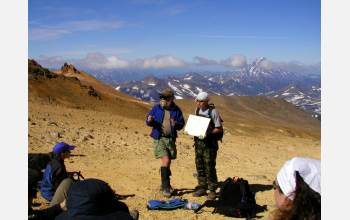|

Press Release 06-018
NSF Awards First Partnership for International Research and Education Grants

Program aims to fortify international research collaborations and engage U.S. scientists and engineers
January 30, 2006
The National Science Foundation (NSF) has awarded the first grants in its Partnership for International Research and Education (PIRE) program. The grants range in size and duration, with most about $2.5 million over five years.
"At a time when scientific and engineering research is becoming increasingly global, this NSF program is designed to enable U.S. scientists and engineers to build strong, long-lasting international research collaborations and to develop a new cadre of globally engaged U.S. scientists and engineers," said Kathryn Sullivan, acting director of NSF's Office of International Science and Engineering, which awarded the PIRE grants.
"The PIRE awards are focused research projects that can only be successful with the collaboration of foreign partners," she said. "They provide strong international research experiences for U.S. students and post-docs, and provide new models for how universities can tap their many resources to become more international."
The PIRE awards support research across the entire spectrum of NSF-funded disciplines, with projects in such areas as the formation of distant galaxies, nanoscience for clean drinking water, computer speech recognition and language translation, patterns of learning by children of immigrants, seismic activity in the Earth's mantle under Africa, and plants and animals unique to Patagonia.
The competition is supported across NSF, with every NSF directorate contributing funds to at least one PIRE award. The geographic distribution of the PIRE collaborations is wide-ranging, with multiple partnerships funded to work in Europe, the Americas, Asia and Africa. Nine of the 12 PIRE partnerships will link U.S. researchers and students with collaborators in multiple foreign countries.
"PIRE activities highlight the fact that many important research questions can best be addressed within an international collaboration and that for the United States to retain its strengths in science and engineering, scientists and engineers must work with colleagues across the globe," said Sullivan.
PIRE projects are characterized by close integration of research and education, extensive student preparation for foreign experiences and strong mentoring during international research, as well as activities that will contribute to developing an international community of scholars at U.S. universities.
PIRE projects, for example:
- use IT resources for distance learning, virtual transcontinental lab meetings, and internationally webcast seminars
- develop research, education and recruitment links with minority-serving institutions
- take advantage of culture and language training to put scientific research in a cross-cultural context
- combine scientific research training with a Peace Corps International Master's program
- develop international curriculum units for students who do not travel
- involve outreach to integrate international research findings into K-12 activities, including offering high-school students research internships in the PIRE laboratories, and
- undertake efforts to enhance public understanding of the international dimensions of science
The PIRE grants were made to Brigham Young University, Johns Hopkins University, Michigan State University, Michigan Technological University, Pennsylvania State University, Princeton University, Rice University, the University of Alaska at Fairbanks, the University of California at Santa Barbara, the University of Massachusetts at Amherst, the State University of New York at Albany, and the University of Rhode Island.
-NSF-

Media Contacts
Cheryl Dybas, NSF (703) 292-7734 cdybas@nsf.gov
Related Websites
PIRE Awards: http://www.nsf.gov/funding/pgm_summ.jsp?pims_id=12819

The National Science Foundation (NSF) is an independent federal agency that supports fundamental research and education across all fields of science and engineering. In fiscal year (FY) 2009, its budget is $9.5 billion, which includes $3.0 billion provided through the American Recovery and Reinvestment Act. NSF funds reach all 50 states through grants to over 1,900 universities and institutions. Each year, NSF receives about 44,400 competitive requests for funding, and makes over 11,500 new funding awards. NSF also awards over $400 million in professional and service contracts yearly.
 Get News Updates by Email Get News Updates by Email
Useful NSF Web Sites:
NSF Home Page: http://www.nsf.gov
NSF News: http://www.nsf.gov/news/
For the News Media: http://www.nsf.gov/news/newsroom.jsp
Science and Engineering Statistics: http://www.nsf.gov/statistics/
Awards Searches: http://www.nsf.gov/awardsearch/
| 

